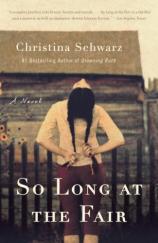So Long at the Fair
Review
So Long at the Fair
It’s pretty hard to write freshly about extramarital affairs --- Tolstoy and Flaubert did it rather well, after all --- and still more difficult to be honest and accurate about how a marriage feels from the inside (if you’ve never been married, you don’t know; if you are married, it feels disloyal). Christina Schwarz attempts both in SO LONG AT THE FAIR, limiting herself rigorously to a single crucial day in the life of a not-so-romantic triangle. Jon and Ginny are a childless couple, neither entirely happy nor desperately mismatched; Freddi is Jon’s advertising agency colleague and mistress.
Schwarz does well with Jon’s sense of being “unmoored” --- his guilty, shifting states of mind as he vacillates between genuine devotion to Ginny and fierce attraction to Freddi. But this is not a novel told from a single-pointed perspective. We also hear what Ginny and Freddi are thinking --- both women are nervous, angry and mostly keeping their true feelings under wraps --- and Jon’s workmate Kaiser, who knows about the affair but hasn’t (yet) spilled the beans. And, just for good measure, we get a creepy look inside the brain of Ethan, the obsessive-compulsive guy with a crush on Freddi.
Schwarz, it seems, wants to examine the affair in Rashomon-like fashion, suggesting that there is no whole, absolute truth to a marriage but only a range of fragmentary visions. She keeps us in suspense about what Jon will do, whether Ginny will find out, and how Freddi and Ethan’s story will develop. All this is plausible. I loved her opening scene, a fight between Jon and Ginny about nothing --- and everything. Schwarz grasps the way one takes the temperature of a vulnerable marriage as with a sick child, alternately feeling safe or uncertain or furious or blessed. She gets its massive presence in an individual’s life, a presence in which love or desire or contentment becomes almost irrelevant.
Jon’s mother told him, when he first became engaged to Ginny, that “marriage is a heavy thing,” and late in the book he realizes she was right: “[H]e saw suddenly, vividly, that that heaviness, that fabric of understandings and misunderstandings, of events witnessed, celebrated, and mourned, of dependable support and casual betrayal, of happy occasions of agreement and of never-ending accommodations both willing and grudging, that union, enduring despite insults and neglect, relentlessly invested with hope, had become the bulk of his life.”
If Schwarz had left it at that, I would have found SO LONG AT THE FAIR an absorbing, intelligent book. However, she chose not only to play with multiple viewpoints and numerous flashbacks, but also to lard the novel with an italicized subplot, a skeletal, murky tale of love and violence from 1963. Its relevance to the main story doesn’t become clear until close to the end of the novel, when we find out how the modern protagonists are related through their parents’ older ties. I can’t say more than that without giving away the plot; suffice it to say that it involves rape, revenge and a near-fatal accident.
I understand that Schwarz might want to use this backstory to suggest how the secrets and dramas of the past ripple out to touch other lives and generations. But I became so confused by the double narratives that at one point I had to make a diagram of the characters and their connections to one another! Old-fashioned historical novels give you family trees at the beginning and helpful maps. Perhaps this tricky breed of modern fiction needs to do the same.
In an interview, Schwarz acknowledges that she had intended the 1963 plot line to be an entirely separate novel; although it grew out of SO LONG AT THE FAIR, “it was obviously too much of a digression to stand as a chapter.” But when a friend commented on the thematic relatedness of the two stories and urged her to make them part of the same book, Schwarz says, “the ol’ break-it-into-italicized-sections idea occurred to me and to my surprise it worked.”
No, it didn’t. I got tired of guessing who was who, and the subplot simply distracted me from the heart of the novel (and its most immediate and compelling aspect): Jon, Ginny and Freddi’s story. There seems to be a vogue these days for writing books that jump between decades or juggle past and present. Well handled, this is a wonderfully complex and evocative technique; done mechanically, it just gums up the works.
SO LONG AT THE FAIR nonetheless has many attractive and satisfying aspects, not the least of which is Schwarz’s skill at recreating the small-town setting. The local country club is an evocative reference point. Once a thriving concern and a locus of assignation and danger, it is now derelict, its golf course a tangled woodland that Ginny, a landscape architect, is hired to work on as part of a high-end housing development. Class tensions, always exaggerated in a community where a few families rule the roost and everybody knows everybody else, rumble underneath the drama. The title isn’t just metaphorical; there is an actual fair (Summerfest, the big music festival held annually near Milwaukee) at which all the protagonists wind up at the end of the day --- and the novel --- in an eventful denouement.
Schwarz is talented. I’ll definitely read her next book, and it was no great hardship to get through this one. I appreciate her sense of place, her powers of observation, and her gift for building ordinary yet fascinating characters. But in SO LONG AT THE FAIR, I’m afraid that she loses sight of the whole and leaves the reader floundering.
Reviewed by Kathy Weissman on January 23, 2011
So Long at the Fair
- Publication Date: July 14, 2009
- Genres: Fiction
- Paperback: 272 pages
- Publisher: Anchor
- ISBN-10: 0307275493
- ISBN-13: 9780307275493




